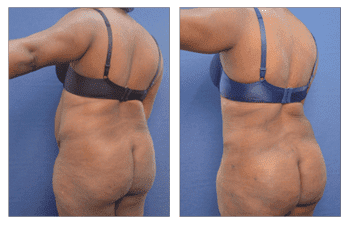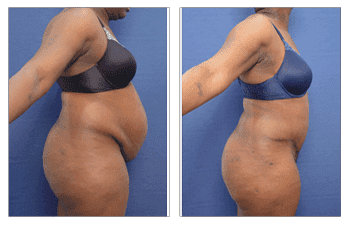



Introduction: Skin Reduction Surgery
Skin reduction surgery is a category of plastic surgery that includes any surgical excisional surgeries. The critical evaluation of every patient desiring body contouring is the consideration of not only excess fat but also redundant skin. Skin reduction surgery is most frequently observed in patients following massive weight loss after a gastric reduction surgery or following botched liposuction. Gastric reduction surgeries are very popular resulting from a pandemic of obesity over the last half a century and result in significant weight loss in the realm of 100 pounds or more. Although weight loss results in a dramatic reduction of excess fat, it does result in significant skin excess. Additionally, a majority of liposuction and body contouring revision surgeries referred to SurgiSculpt arise from prior liposuction procedures that were performed without recognizing undesirable skin texture changes or redundancy. This inadvertent mistake results in significant contour irregularities that can only fully be corrected with skin reduction surgery.
Skin reduction surgeries were developed to address skin redundancy that can cause wrinkling and overlying contour irregularities; this deformity can be quite unsightly and poorly affect patient morale. This detrimental effect has been characterized as the melted candlestick phenomenon in gastric reduction patients. In summary, the utilization of skin reduction procedures is a key component of high definition body contouring procedures.
What Are Your Skin Reduction Surgery Options
Whether you are a drastic weight loss, post-bariatric surgery patient, trying to regain your body after pregnancy, or have experienced a botched liposuction procedure, reduction surgery can enable your plastic surgery transformation.
Surgical options include excisional surgery such as a tummy tuck or breast lift, Renuvion skin tightening, and/or VASER liposuction While VASER technology does allow for a bit more skin retraction compared to traditional technologies, it still needs to be accompanied by either excision surgery or Renuvion skin tightening. Being able to interweave these techniques and technologies together is what makes SurgiSculpt surgeons some of the top body contouring surgeons in the world. Let us discuss skin reduction surgery in more detail.
What is excess skin reduction surgery?
Excess skin reduction surgery, also known as body contouring, is a surgical procedure aimed at removing and tightening sagging or loose skin that often occurs after significant weight loss or from the natural aging process. This surgery typically involves various body contouring procedures such as arm lift, breast lift, tummy tuck, thigh lift, and lower body lift to improve the overall body shape and appearance.
The stages of excess skin reduction surgery usually involve initial consultation and assessment, pre-operative preparation, the actual surgical procedures, and post-operative care and recovery. Depending on the extent of excess skin, some individuals may require multiple surgeries to achieve the desired results.
The recovery process after excess skin reduction surgery can be somewhat painful and may involve swelling, bruising, and discomfort, which can be managed with prescribed pain medications. Patients are typically advised to take it easy and limit strenuous physical activity during the recovery period. The recovery process can vary depending on the individual, but most patients can expect to see noticeable improvement in their body contour within a few weeks to months after the surgery.
Who does excess skin affect?
Excess skin commonly affects individuals who have undergone significant weight loss, whether through bariatric surgery or diet and exercise. The stretching and loss of elasticity in the skin and tissue occur when carrying extra weight, as the skin has to expand to accommodate the increased mass. However, once the weight is lost, the skin may not be able to fully retract, leading to sagging skin.
The impact of excess skin on an individual’s comfort, how clothes fit, and their ability to exercise can be significant. Excess skin can cause discomfort and irritation, especially in areas where skin folds over itself. Clothes may not fit properly, leading to frustration and self-consciousness. Additionally, the excess skin can interfere with exercise and physical activity, making it harder to move comfortably and potentially leading to skin chafing and rashes.
For individuals who have worked hard to achieve their weight loss goals, excess skin can be a very real and discouraging issue that affects their everyday life and well-being.
Why do people have excess skin removal surgery?
Excess skin removal surgery, also known as body contouring, is often sought after by individuals who have undergone major weight loss. Excess skin can not only impact a person’s physical appearance, but it can also have a significant effect on their self-confidence. The presence of sagging skin can make it difficult for individuals to feel comfortable and confident in their own bodies, which can impact their mental well-being.
Moreover, excess skin can also lead to physical challenges, such as skin irritations, rashes, and difficulty with daily activities. The emotional and physical challenges associated with excess skin can greatly affect a person’s quality of life and overall comfort. Excess skin removal surgery provides a solution to these challenges, as it helps to improve one’s physical appearance and self-esteem.
Additionally, body contouring procedures can address the excess skin and provide a more contoured and proportionate body shape, further enhancing an individual’s appearance and overall comfort. Overall, excess skin removal surgery can greatly improve the quality of life for individuals who have undergone major weight loss, addressing both the physical and emotional challenges associated with excess skin.
Who is a candidate for excess skin reduction surgery?
Candidates for excess skin reduction surgery must meet certain criteria to ensure the success of the procedure and minimize potential risks. Firstly, candidates should have maintained a stable weight for at least six months, demonstrating a commitment to a healthy lifestyle and reducing the likelihood of future weight fluctuations impacting the results of the surgery. Additionally, candidates should be in good general health, with no underlying medical conditions that could complicate the surgical process or recovery.
It is also important for candidates to have realistic expectations of the surgery, understanding that while excess skin can be reduced, some scarring may result. Candidates should be prepared for the potential scarring and have a clear understanding of the expected outcomes of the surgery. Finally, candidates should be able to take time off for recovery, as the healing process post-surgery is crucial for achieving optimal results.
In summary, suitable candidates for excess skin reduction surgery should have maintained a stable weight, be in good health, have realistic expectations, be aware of potential scarring, and be able to dedicate time for recovery.
What are the types of excess skin removal procedures?
Types of excess skin removal procedures include arm lift (brachioplasty), breast lift (mastopexy), facelift (rhytidectomy), lower body lift, panniculectomy, thigh lift, and tummy tuck (abdominoplasty).
– Arm lift: Targets excess skin on the upper arms and can benefit patients who have lost a significant amount of weight or have sagging skin due to aging.
– Breast lift: Targets sagging or deflated breasts and can benefit patients who have experienced changes in breast shape and firmness due to pregnancy, breastfeeding, or weight loss.
– Facelift: Targets sagging skin on the face and neck and can benefit patients who want to achieve a more youthful and refreshed appearance.
– Lower body lift: Targets excess skin on the abdomen, buttocks, and thighs and can benefit patients who have lost a significant amount of weight and are left with loose, hanging skin.
– Panniculectomy: Targets the lower abdomen and can benefit patients who have an overhanging apron of excess skin and fat after significant weight loss.
– Thigh lift: Targets sagging skin on the inner or outer thighs and can benefit patients who have lost a significant amount of weight or have excess skin due to aging.
– Tummy tuck: Targets excess skin and fat on the abdomen and can benefit patients who want to achieve a firmer, flatter abdominal contour, especially after childbirth or weight loss.
What can I expect before excess skin removal surgery?
Before undergoing excess skin removal surgery, you will need to undergo blood work to ensure that you are in good health for the procedure. Additionally, you may be required to discontinue certain medications and supplements that could interfere with the surgery or the healing process. It is also important to stop smoking or using tobacco products in the weeks leading up to the surgery, as this can affect your body’s ability to heal properly.
Excess skin removal surgery can be a multi-phase process, involving different combinations of surgeries such as tummy tucks, arm lifts, thigh lifts, and breast lifts. Depending on the extent of the surgery, you may need to stay overnight in the hospital for observation.
The surgery is typically performed in a hospital or surgical center under general anesthesia. The location of the surgery will depend on the specific procedures being performed and the recommendations of your surgeon.
After the excess skin removal surgery, body contouring procedures may be performed to further enhance your results, such as liposuction or additional tissue tightening. By eliminating extra skin after weight loss, you can enjoy benefits such as improved mobility, reduced risk of skin infections, and a more contoured appearance.
What happens during excess skin reduction surgery?
Excess skin reduction surgery, also known as body contouring procedures, involves the removal of excess skin and tissue following significant weight loss. This process often requires a combination of different surgeries to achieve the desired results, such as a tummy tuck, thigh lift, arm lift, and breast lift. In some cases, multiple surgeries may be necessary to address excess skin in different areas of the body.
The surgery can take place in a hospital or surgical facility, depending on the patient’s specific needs and the extent of the procedures being performed. Additionally, because of the complexity of excess skin removal, the surgery may be planned in stages to ensure the best outcomes and reduce the risk of complications.
During the surgery appointment, various types of excess skin removal procedures may be combined to address the patient’s individual needs, such as liposuction to remove stubborn fat deposits, body lifting to tighten and recontour sagging skin, and breast augmentation or reduction to improve breast appearance.
Overall, excess skin reduction surgery is a comprehensive and personalized approach to achieving a more sculpted and toned body after significant weight loss.
Does excess skin reduction surgery cause scarring?
Excess skin removal surgeries cannot take place at the same time as another weight loss surgery, such as bariatric surgery. This is because the excess skin must be removed after achieving the goal weight from the initial weight loss surgery. There are two types of surgeons who perform these procedures: bariatric surgeons, who specialize in weight loss surgeries, and plastic surgeons, who specialize in excess skin removal and body contouring.
After achieving the desired weight loss, patients can then consult with a plastic surgeon to discuss the removal of excess skin. In some cases, combined procedures such as liposuction and body contouring may be recommended to further enhance the body’s appearance. These combined procedures can help to address both excess fat and skin, resulting in a more sculpted and contoured physique. It is important for individuals to carefully consider the timing and sequencing of these surgeries in order to achieve the best results and minimize risks.
How painful is excess skin reduction surgery?
Excess skin reduction surgery, also known as body contouring, can cause moderate to severe pain during the recovery process. Patients may experience discomfort, soreness, and tightness in the areas where excess skin has been removed. Pain management is an essential part of the recovery process, and medications such as prescribed pain relievers and anti-inflammatories are commonly used to manage the discomfort.
Despite the initial pain, excess skin reduction surgery can greatly improve comfort and the fit of clothing. It can also make exercising easier as the excess skin is no longer hindering movement. The different types of procedures involved in excess skin reduction surgery include lower and upper body lifts, thigh and buttock lift, and panniculectomy, which target specific areas of excess skin to provide a more contoured appearance.
Overall, while excess skin reduction surgery can be a painful experience, the benefits in terms of improved comfort and body contouring can be well worth it for individuals who have lost a significant amount of weight and are dealing with excess skin issues.
A 44-year-old patient 3 months status post a skin reduction surgery including a full tummy tuck with muscle plication and body contouring, including HD liposuction of the upper, middle, and lower back.
What are the potential risks or complications of excess skin removal surgery?
Excess skin removal surgery, also known as body contouring procedures, carries potential risks and complications that patients should be aware of. Common risks include bleeding, changes in skin sensations, infections, and scarring, as referenced in the background information. In addition, potential complications may include seroma (fluid accumulation under the skin), hematoma (a collection of blood outside of blood vessels), deep vein thrombosis, pulmonary embolism, delayed wound healing, asymmetry, nerve damage, and anesthesia-related risks. Other possible outcomes of these procedures may include contour irregularities, persistent pain, skin discoloration, and the need for additional surgeries to correct any complications. It is important for individuals considering excess skin removal surgery to thoroughly discuss these risks and potential complications with their surgeon and to carefully weigh the benefits and potential drawbacks of these procedures.
What is recovery like after excess skin reduction surgery?
After excess skin reduction surgery, the typical recovery process involves a period of rest and limited physical activity. Patients can expect to experience swelling, bruising, and discomfort for the first few weeks following the surgery. As the body heals, the swelling will gradually subside, and the incision sites will heal. The duration of the recovery period can vary depending on the individual’s health and the extent of the surgery, but it generally takes about 4-6 weeks to start feeling back to normal.
During the recovery period, patients may have drainage tubes in place to prevent fluid buildup, and frequent bandage changes may be necessary to ensure proper healing. Post-operative care instructions typically include keeping the incision sites clean and dry, avoiding strenuous physical activity, avoiding heavy lifting, and elevating the knees when sitting or lying down.
Overall, it is important to follow the specific post-operative care instructions provided by the surgeon and to be mindful of any limitations on physical activity to ensure a smooth recovery process.
How soon will I see results after excess skin removal surgery?
After excess skin removal surgery, the timeline for seeing results varies from person to person. Initially, there will be swelling and bruising, and it may take a few weeks for these to subside. Within 1-2 months, you may begin to notice improvements in the contour and appearance of the treated area. However, the complete healing process can take up to 6-12 months, during which time the scar will continue to fade and the outcome will become more apparent.
Factors such as weight fluctuations, age, and overall health can affect the long-term results of body contouring surgery. Maintaining a stable weight and a healthy lifestyle is important to preserve the improvements achieved by the surgery.
Before the surgery, your doctor may recommend getting blood work and avoiding certain medications or substances that could interfere with the procedure or recovery process.
In conclusion, while initial improvements may be noticeable within a few weeks to months, the complete healing and outcome of excess skin removal surgery can take up to a year. The long-term results depend on factors such as weight stability and overall health.
How long do results from excess skin removal surgery last?
The results from excess skin removal surgery can last for many years, or even a lifetime, depending on a variety of factors. The longevity of the results is influenced by the individual’s overall health, age, genetics, and lifestyle choices. Factors such as smoking, excessive sun exposure, and poor skincare can impact the lasting effects of the surgery.
Weight fluctuations can also affect the results of body contouring surgery. Significant weight gain or loss can cause the skin to stretch or sag again, possibly compromising the initial results. It can take several months to a year to achieve the final results of body contouring surgery, as the body needs time to heal and settle into its new shape.
Maintaining a stable weight after excess skin removal surgery is crucial for ensuring long-lasting results. By following a healthy diet and regular exercise routine, patients can preserve the outcome of the surgery and avoid further skin laxity. Consulting with a healthcare professional and adhering to their instructions can help individuals maintain their desired results for as long as possible.
Conclusion: Skin Reduction Surgery
In conclusion, skin reduction surgery plays a crucial role in helping weight loss patients reclaim their health and improve their quality of life. After significant weight loss, many individuals are left with excess skin that not only affects their appearance but also hinders their ability to fully enjoy the benefits of their weight loss journey. Skin reduction surgery helps to remove this excess skin, allowing patients to feel more comfortable in their own bodies and enhancing their overall well-being.
Furthermore, body contouring procedures, including skin reduction surgery, are important in reducing the risk of weight regain. By removing excess skin and sculpting the body to better proportions, patients are more likely to maintain their weight loss long-term. Additionally, having procedures on multiple body areas can lead to better long-term outcomes, as it ensures a more balanced and harmonious contour.
Overall, skin reduction surgery and body contouring procedures are essential for weight loss patients to fully embrace their new, healthier lifestyles and to prevent the frustration of dealing with excess skin. These surgeries not only improve the physical appearance but also contribute to a higher quality of life and overall sense of well-being.
Skin Reduction Surgery Case Study: This 44-year-old patient came to SurgiSculpt for a body contouring consultation. She scored much lower on the HDL body scale in the front compared to the back due to her skin redundancy in the abdomen. She needed a full abdominoplasty to reduce the excess skin of the abdomen. In contrast, due to the limited skin redundancy in the back, we used VASER liposuction to perform back contouring If you are interested, contact SurgiSculpt for a free consultation today.GH
